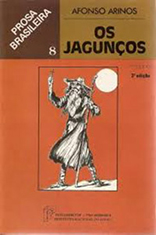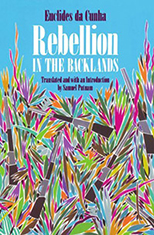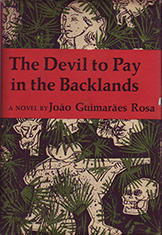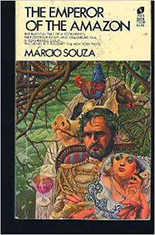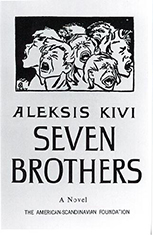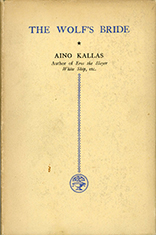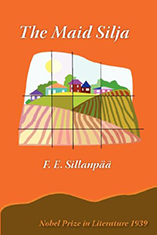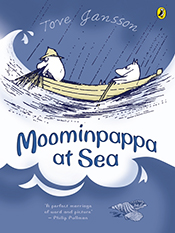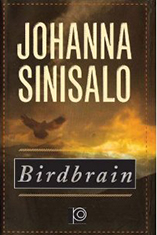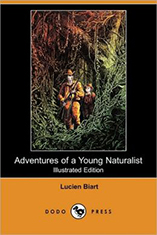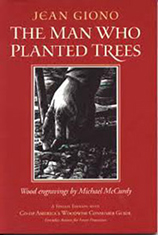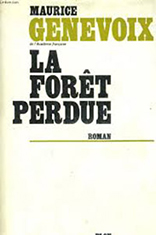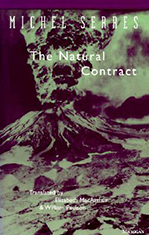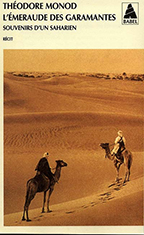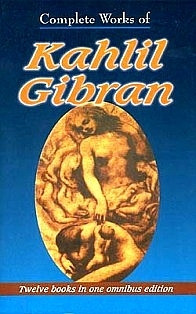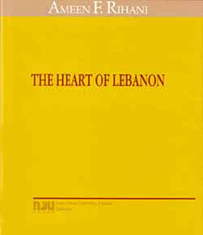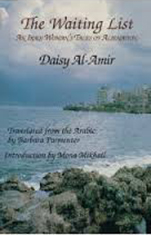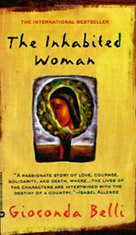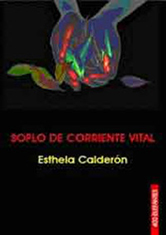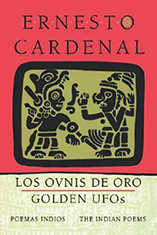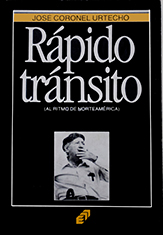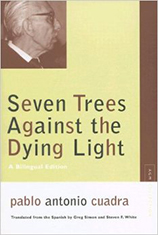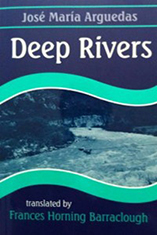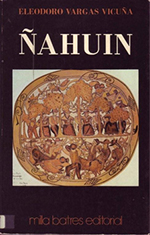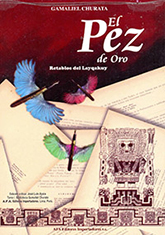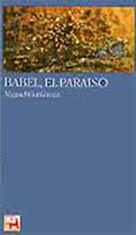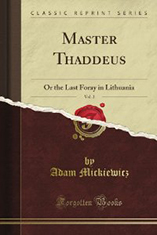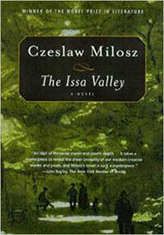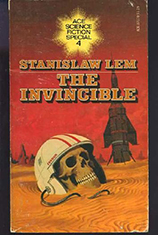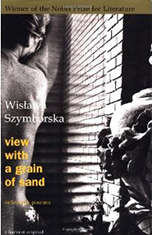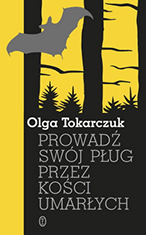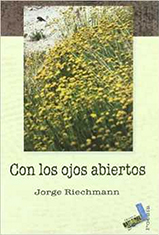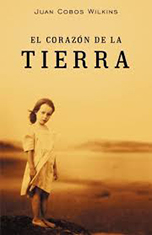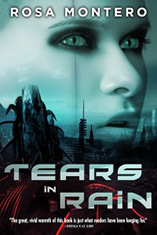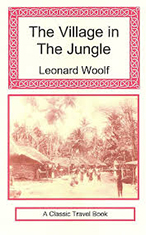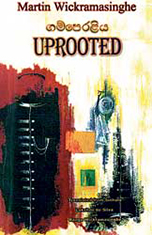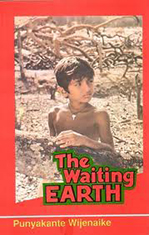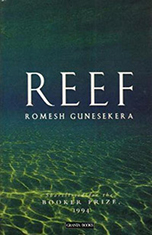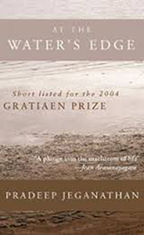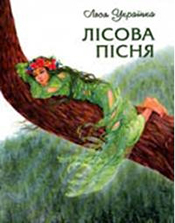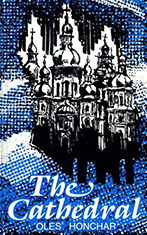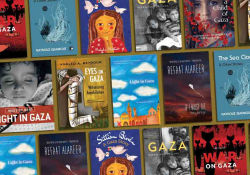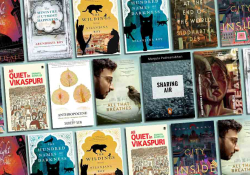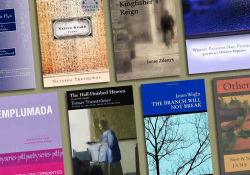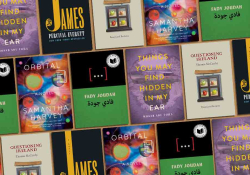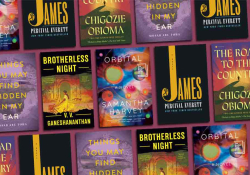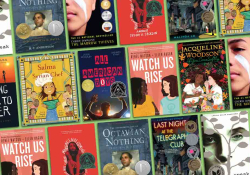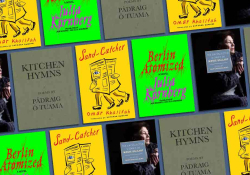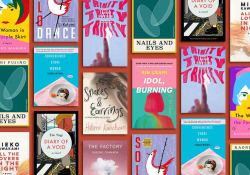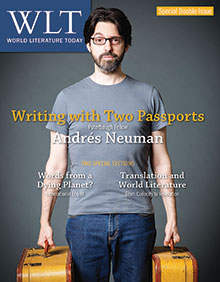A Booklist of International Environmental Literature, Part 2
World Literatuture Today published an earlier version of this booklist of international environmental literature in its January 2009 issue offering selections from seventeen countries or regions throughout world, from Argentina to the United Kingdom. For this new booklist, I have invited scholars and writers from ten countries not represented in the previous list (or with expertise in the literary traditions of those countries) to offer their choices of important authors and works that they would recommend to international readers interested in environmentally relevant work. As in the case of the 2009 booklist, I asked the contributors to the list to limit their choices to five (this was quite painful for many of them!) and to choose works from the past 250 years that they feel achieve “literary quality” and popular appeal. The more we learn about the wealth of environmental thought and expression from a new group of fascinating cultures, the more poignantly we realize how many other regions of the world have not yet been featured in these lists.
Brazil
Compiled by Zélia Bora
Universidade Federal da Paraiba, Brazil
Inocência (1872)
By Alfredo d’Escragnolle Taunay (Viscount of Taunay), Inocência (1872; Innocence)
The literary project of Viscount Taunay explored new aspects of the relationship between man and environment. This novel, whose name derives from a town in the state of Mato Grosso do Sul, is considered his masterpiece. The novel, which is considered a precursor to naturalism in Brazilian literature, presents a story of displacement. Most of the characters move to the interior of Brazil through “wild regions” in search of their own identities. Today these regions encompass the states of Minas Gerais, Goiás, and Mato Grosso do Sul. In Inocência, the natural world is represented as a character.
Os jagunços (1898)
By Afonso Arinos de Melo Franco, Os jagunços (1898; The outlaws)
Afonso Arinos was one of the first writers to introduce the genre of “faction” in Brazilian literature, which he did in order to narrate the War of Canudos through his novella Os jagunços. The actual events took place in the backwoods of Bahia and provide interesting analysis of the relationship between humans and environment. Besides Os jagunços, he also wrote Histórias e paisagens (Stories and landscapes), which came out in1921.
Os Sertões (1902)
By Euclides da Cunha, Os Sertões (1902; Eng. Rebellion in the Backlands, 1944 / Backlands: The Canudos Campaign, 2010)
The narrative of Euclides da Cunha initially adopts the perspective of his literary predecessors in viewing the backlands as an “Other” in the national space. Da Cunha’s perspectives were developed when, as a journalist, he was invited to cover an outbreak of violence in a poor community called Canudos. Reporting on this experience brought da Cunha to a place in the Brazilian intellectual history through his romantic representation of the 1896–97 war between royalist peasants and republican soldiers. Some years later, da Cunha used the same clarity and knowledge to write about the interactions between humanity and the environment in Amazon. These observations were recorded in works published after his death: À Margem da história (1975, In the margins of history), Um paraíso perdido: ensaios, estudos e pronunciamentos sobre a Amazônia (1994, A paradise lost: essays, studies, and pronouncements on the Amazon), and Contrastes e confrontos (1996, Contrasts and confrontations).
Grande sertão: veredas (1956)
By João Guimarães Rosa, Grande sertão: veredas (1956; Eng. The Devil to Pay in the Backlands, 1963)
Considered the most important Brazilian writer in the mid-twentieth century, Rosa wrote a documentary style of fiction that recorded rural life in the inland region of Minas Gerais, his native state. His novel Grande sertão: veredas is a poetic masterpiece that tells the story of a former bandit, Riobaldo Tatarana, who has become a landowner. This is an interesting work of environmental writing in its representation of the symbolic and magical dimensions of the landscape.
Galvez, imperador do Acre (1976)
By Márcio Souza, Galvez, imperador do Acre (1976; Eng. The Emperor of the Amazon, 1980)
An outstanding author and playwright, Souza’s work is produced through aesthetic motivations that take into account the profound sense of identity represented by the most iconic environment in Brazil: the Amazon. The Amazon is depicted not only as a geophysical region but as multidimensional space that allegorizes the various cultural tensions between native inhabitants and immigrants in northern Brazil. Among Márcio Souza’s works, the satirical novel Galvez, imperador do Acre is particularly acclaimed for its critical treatment of colonialism.
Finland
Compiled by Toni Lahtinen, University of Tampere, Finland & Markku Lehtimäki, University of Eastern Finland
Seitsemän weljestä (1870)
By Aleksis Kivi, Seitsemän weljestä(1870; Eng.Seven Brothers, 2005)
It has often been suggested that the tradition of Finnish literature has its beginnings in the forests. A first-rate example of this is Seven Brothers, by Aleksis Kivi, the national author of Finland. The first significant novel written in Finnish, it is still widely regarded as the single most important book in the Finnish canon. No other text has shaped the Finns’ perceptions of themselves, their realities, and their dreams as strongly as Kivi’s novel. The brothers’ rebellious escape from agrarian society into the wilderness is a self-consciously Cervantesque story that carnivalizes the Romantic idea of man’s return to nature.
Sudenmorsian (1928)
By Aino Kallas,Sudenmorsian (1928; Eng. The Wolf’s Bride, 1930)
This poetic and archaic werewolf story by Finnish-Estonian author Aino Kallas reflects contemporary historical developments, especially the rise of the “new woman” in the Roaring Twenties. The allegorical and daring novel tells the story of a forester’s wife who turns into a wolf and starts to roam the woods that are represented as sensualized realms. Despite the obvious and, at the time, fashionable psychoanalytical elements, The Bride of the Wolf is also a tragic story about men’s attempts to control and overpower a feminized and mystified nature.
Nuorena nukkunut (1931)
By F. E. Sillanpää, Nuorena nukkunut (1931; Eng.The Maid Silja, 1933)
F. E. Sillanpää is the only Finnish author ever to win the Nobel Prize in Literature. It was awarded to him on the brink of World War II “for his deep understanding of his country’s peasantry and the exquisite art with which he has portrayed their way of life and their relationship with nature.” The Maid Silja is arguably the author’s most popular and internationally acknowledged novel, but Sillanpää’s distinctive idea of the unity of nature and man—something that literary critics have started to call his biological determinism—can be found in the author’s other works as well.
Muumipappa ja meri (1965)
By Tove Jansson, Muumipappa ja meri (1965; Eng.Moominpappa at Sea, 1966)
Tove Jansson is one of the best-known Finnish-Swedish authors, and her Moomin series has been translated into more than sixty languages. Classified as a children’s picture book, the title of Muumipappa ja meri is a clear allusion to Ernest Hemingway’s modern classic The Old Man and the Sea (1952), and Jansson’s multilayered novel is, in fact, more a narrative for adult readers than a bedtime story for young children. In this fascinating tale, Jansson rewrites the classic genre of Robinsonades, in which the themes of masculine identity and manly heroism are traditionally connected to the mastery of nature.
Linnunaivot (2008)
By Johanna Sinisalo, Linnunaivot (2008; Eng. Birdbrain, 2011)
Johanna Sinisalo, one of the most critically acclaimed contemporary Finnish writers, represents the genre of the New Weird that often deals with the relationship between the human and the nonhuman. Sinisalo’s works typically grapple with serious environmental concerns, developing them into crucial ethical themes. Birdbrain tackles Western consumer culture and the human yearning for extreme experiences. It is the story of two lovers trekking through the undisturbed wilderness of Tasmania, a paradise that is eventually transformed into a heart of darkness.
France
Compiled by Françoise Besson
Université Toulouse-Le Mirail, France
Aventures d’un jeune naturaliste (1869)
By Lucien Biart, Aventures d’un jeune naturaliste (1869; Eng. Adventures of a Young Naturalist, 1871/2013)
This book for children was written by Lucien Biart, a botanist, pharmacist, and doctor of medicine. Aventures d’un jeune naturaliste tells the story of a boy living with his parents in Mexico and asking his father to take him on one of his expeditions in the forest. Their adventures are an opportunity for the boy and the readers to discover “natives” but also a chance to encounter plants and animals in the forest. The narrative highlights the richness and beauty of nature, the relationship of men with plants and animals, allusions to deforestation, and the repeated insistence on the refusal to kill animals when it is not necessary, aiming to instill in children a respect for nature.
“L’homme qui plantait des arbres” (1953)
By Jean Giono, “L’homme qui plantait des arbres” (1953; Eng. “The Man Who Planted Trees,” 1985)
This short story, translated into thirteen languages, tells the story of a shepherd planting trees and transforming a desert into a beautiful place to live in, where water flows again and houses with gardens replace ruins. The free generosity of the man, who had lost his son and wife and decides to give life again to an apparently barren place and ceaselessly plants trees while two wars destroy the country, shows the power of each individual’s actions. The short story mingles the tones of a fable and a realistic narrative: the character is imaginary, but the place it deals with, the Forest of Vergons, was really transformed by reforestation, as 100,000 hectares of trees have been planted since World War I. The tale shows the effectiveness of a small gesture, made by a single man, which results in the transformation of a landscape and the renewal of life where it had nearly disappeared. In 2005 Wangari Maathai, Kenyan environmentalist and winner of the Nobel Peace Prize, published a new foreword to the English translation of Giono’s classic tale.
La Forêt perdue (1967)
By Maurice Genevoix, La Forêt perdue (1967; The lost forest)
This is the third novel of a trilogy, following Raboliot and La dernière harde; it is an initiatory novel in which the forest speaks about man’s predicament and the necessity for him to respect the forest and the creatures living in it. Genevoix’s philosophical meditation on life and death is sustained by his observations of the natural world and his empathy with nonhuman creatures. The violence and death of hunting scenes give way to the magic of the forest in communion with those who can hear its voice and understand its language. The fate of a deer, born from the sentence of a storyteller, symbolically makes men aware of their own fragility in comparison with the noble strength of animal life and its absolute beauty, transcending even death. The novelist’s descriptions of trees, plants, and animals in the forest convey the beauty of nature and the living strength that emanates from it. This novel does not speak abstractly about the protection of nature: it shows the absolute necessity of preserving the planet’s vitality.
Le Contrat naturel (1990)
By Michel Serres, Le Contrat naturel (1990; Eng. The Natural Contract, 1995)
This essay gives a philosophical answer to the dangers threatening the planet. The book questions man’s attitude toward the earth. The solution to the damages caused by man’s exploitation of the planet’s resources dwells in the association of two laws: “to love one another,” which implies not only caring for our neighbor but caring for all of mankind; and “to love the world,” this second law being divided into the local law linking us to the ground where our ancestors lie and a new global law encompassing the whole planet. Evoking history, science, politics, and education, Serres urges readers to learn love for the world and to teach love. The book answers and completes Rousseau’s Le Contrat social and places man’s duties to the earth at the core of human ethics. Serres advocates the necessity of an agreement of reciprocity, a symbiosis between humans and the earth.
L’émeraude des Garamantes (1992)
By Théodore Monod, L’émeraude des Garamantes (1992; The emerald of Garamantes)
In L’émeraude des Garamantes—which follows Méharées, the wise man of the desert as he was often called, a botanist, zoologist, and naturalist—Théodore Monod thinks about man’s way of being in the world through his own experience. Monod’s fascination for the Jardin des Plantes in Paris when he was a child led him to his curiosity about nature. His walks in the Sahara Desert were part of his fight for the preservation of the desert and for ecosystems more widely. From the beautiful description of the desert of Sahara to a mythical gem allowing him to speak about the various stones that can be found here and their exploitation, he introduces readers to the desert through its landscapes, stones, plants, animals, and men living in it. In this book, Monod speaks about the animal condition in a philosophical way, insisting that the animal is not an object and that it is necessary for the human conscience to open up and recognize the ethical implications of our treatment of other species.
Lebanon
Compiled by Marianne Marroum
Lebanese American University
The Complete Works: The Original Texts in English and Arabic (2010)
By Khalil Gibran, The Complete Works: The Original Texts in English and Arabic (2010)
Khalil Gibran, the artist and writer, was born in the village of Bsharri, in northern Lebanon, in 1883. He later immigrated with his family to the United States, where he studied art and began his literary career, writing in both English and Arabic. The author of numerous works, he became world famous for The Prophet (1923). Though Gibran was known for his romantic and symbolic style, one cannot ignore the ecological themes that permeate his works. His corpus is replete with references to nature. His name will always be associated with Bsharri and the beautiful valley of Wadi Kannoubine, which he often described in his writings. In al-Bada’i’ waal-Tara’if (The New and the Marvellous, 1923), he eulogizes the earth in an essay titled “O Earth!” In Sand and Foam: A Book of Aphorisms (1926), he states, “Trees are poems that the earth writes upon the sky. We fell them down and turn them into paper that we may record our emptiness.”
al-Muffakirah al-Rifiyyah (1943)
By Amin Nakhle, al-Muffakirah al-Rifiyyah (1943; The rural diary)
Amin Nakhle, a prominent author who was born in 1906, is well known for the poetic prose of his al-Muffakirah al-Rifiyyah. Critics describe this as a rural anthology in which Nakhle puts forth a kaleidoscopic view of village life in the work’s three sections: “In Mountainous Countries,” “Rural Saying and Proverbs,” and “Life in the House of Foaud Afandi.” He tackles various topics such as nature, agriculture, countryside prayers, rural relationships, shepherds, literature, and nature, to name a few, and presents his thoughts in encyclopedia-like entries.
Qalb Lubnan (1947)
By Ameen Rihani, Qalb Lubnan (1947; Eng. The Heart of Lebanon, 2005)
Ameen Rihani is a Lebanese American writer who was born in 1876 in Fureika, Lebanon, and immigrated to the United States in 1888. Rihani was a major figure in the mahjar literary movement developed by Arab emigrants in North America. The Heart of Lebanon, a work of travel literature, contains poetry, history, and personal narrative. In this book, Rihani gives an account of nine journeys he took to several areas in Lebanon. He vividly describes Lebanese life in the first half of the twentieth century, extoling the beauty of the landscape.
Ala la’ihat al-Intizar (1988)
By Daisy al-Amir, Ala la’ihat al-Intizar (1988; Eng. The Waiting List, 1994)
In this collection of short stories, there is one in particular that stands out for both its ecological stance and its cultural significance. Entitled “The Wailer,” it tells the story of a woman who cannot sleep because of the nightly wailing she hears. She discovers that the cry comes from a tree that was uprooted and transported to another location in order to reforest a barren area. Its branches, unlike those of the other trees, were bending down day by day until they reached the ground, and its leaves withered because it was taken away from the river that used to quench its thirst. Though the tree died and the wailing stopped, the woman still could not sleep and wept for the loss of this tree that was unable to adapt to its uprooting, or “immigration,” as the woman perceived it.
The Lost Space: The Views of Lebanese Authors and Artists on Nature (2009)
By Al Mada al Mafquoud, The Lost Space: The Views of Lebanese Authors and Artists on Nature (2009)
This is a collection of short essays commissioned by the Cultural Association of George Yammine, the deceased Lebanese poet, media officer, and critic of literature and art (1955–2000). In these essays, a number of prominent Lebanese authors and artists put forth their perceptions of nature and the landscape that surrounds them in Lebanon and underscore its impact on their creative work. Some of the themes they tackle include the romantic experience of nature, nostalgia for the green Lebanon of the past, and the beauty of the Lebanese landscape. Other authors, by contrast, present images of a degraded environment and try to inculcate ecocentric values among readers. There are also contributions to the book that suggest pragmatic solutions to environmental destruction, including reconfigurations of the Lebanese landscape in a sound ecological manner.
Nicaragua
Compiled by Steven F. White
St. Lawrence University
La mujer habitada (1993)
By Gioconda Belli, La mujer habitada (1993; Eng. The Inhabited Woman, 1995)
Two separate narratives merge in Gioconda Belli’s novel: the first is told by a Nicaraguan woman named Lavinia, who becomes increasingly involved in a revolutionary struggle to overthrow a dictatorship in a country that closely resembles Nicaragua in the 1970s. The second story, about native resistance to the Spanish conquest, is told by an indigenous woman who is reincarnated inside an orange tree on Lavinia’s patio. It is this voice, with its rooted connection to the land, that gives the novel an ecofeminist perspective on political commitment and sacrifice.
Soplo de corriente vital (2008)
By Esthela Calderón, Soplo de corriente vital (2008; Breath of vital current)
In this pioneering collection of ethnobotanical poems, Esthela Calderón draws on her family’s knowledge of medicinal plants and her own lifelong personal encounters with a wide variety of plant species from the western part of Nicaragua. Roberto Forns-Broggi has called Calderón’s poem “La que hubiera sido” (The woman I could have been) “a model of environmental knowledge.”
Los ovnis de oro (poemas indios) (1992)
By Ernesto Cardenal, Los ovnis de oro (poemas indios) (1992; Eng. Golden UFOs: Indian Poems, 1992)
The indigenous past in Ernesto Cardenal’s poetry is a register of the poet’s utopian political ideas, which, he believes, provide a way of living more responsibly on the earth. The numerous Amerindian cultures portrayed in these poems provide a sharp contrast to the capitalist, colonialist, and anti-ecological values of the United States, which threaten the well-being of the planet that future generations will inherit. For Cardenal, human survival depends on the respectful balance we are able to establish with the world we inhabit. An especially powerful poem is “Tahirassawichi in Washington,” in which an indigenous leader speaks directly to the powers that be in the capital of the United States with a sharp ecological awareness.
Rápido tránsito (1959)
By José Coronel Urtecho, Rápido tránsito (1959; Rapid transit)
The most ecologically significant section of José Coronel Urtecho’s book of prose recollections and reflections is the chapter entitled “Viajeros en el Río” (Travelers on the River), which re-creates the journeys along the San Juan River (on the border between Nicaragua and Costa Rica and the site of the recent scandalous clear-cutting of old-growth forest by the Costa Rican government) of Ephraim George Squier (1822–1888), the author of Nicaragua: Its People, Scenery, Monuments, and Mark Twain, who recounts his trip from San Francisco to New York via the isthmus on vessels owned by the tycoon Cornelius Vanderbilt in Travels with Mr. Brown. Teachers of U.S. history may wish to use this source as a way of approaching the ecological consequences of the California Gold Rush, which resulted in the devastation of Nicaraguan forests that were exported to the West Coast of the United States to create much of the infrastructure for American mining operations. In addition, the San Juan River, described in exquisite detail by Twain, is now a potential site for the new efforts, with Chinese investment and engineering, to create an interoceanic canal.
Siete árboles contra el atardecer (1987)
By Pablo Antonio Cuadra, Siete árboles contra el atardecer(1987; Eng. Seven Trees against the Dying Light, 2007)
Taking Aeschylus’s The Seven against Thebes as a point of departure for treating the theme of a civil war, Cuadra writes seven long poems, each on a different species of tree common to the Nicaraguan landscape: Ceiba pentandra, Spondias purpurea, Sterculia apetala, Theobroma cacao, Mangifera indica, Pithecellobium saman, and Crescentia cujete. The trees in this poetry, which was composed during the violent years of the insurrection that toppled the Somoza dictatorship (1978–79), are described with great botanical precision and are linked to their appearances in the history of Nicaragua as told by the Spanish chroniclers and also the mythology of the Aztec and Mayan cultures. This is a work that lends itself especially well to ecocritical analysis and its terminology (such as topophilia, biophilia, the invisible landscape, and the more-than-human world).
Peru
Compiled by Roberto Forns-Broggi
Metropolitan State University, Colorado
Los ríos profundos (1958)
By José María Arguedas, Los ríos profundos (1958;Eng. Deep Rivers, 1978)
This novel is a classic tale from a crossroads by a young “mestizo” narrator who is absorbed in the cultural densities of Andean life with passion and innocence. Written in a Spanish poetized and torn by Quechua words and grammar, its descriptions of indigenous struggles and festivities can be considered as an Earth Song. How can we do justice to the beauty of the complex and cosmic resonances of a little toy “Zumbayllu”? José María Arguedas’s work challenges and invites readers to absorb its environmental wisdom and sensitive presentation of indigenous culture.
Ñahuín (1976)
By Eleodoro Vargas Vicuña, Ñahuín (1976; Her eyes)
This brief collection of short stories, written between 1950 and 1976, is a series of delicate portraits of water, land, trees, wind, bulls, and people. It expresses an existential mesh that is key to an understanding of life and death from an environmental viewpoint. Eleodoro Vargas Vicuña offers a poetic formulation of a world in which human life is intimately connected to nonhuman beings.
El pez de oro. Retablos del Layqakuy (1957)
By Gamaliel Churata, El pez de oro. Retablos del Layqakuy (1957; Gold fish. Wizard Lakhakuy’s reredos)
Gamaliel Churata’s avant-garde novel articulates Andean intelligence through foundational Aymara and Quechua mythologies from the Lake Titicaca region. This polyphonic composition of songs, poems, aphorisms, and philosophical dialogues between distinct nationalities and ways of being, full of Aymara and Quechua names and notions, expresses the ritualistic experience of a place. It challenges hegemonic, nonindigenous knowledge by articulating a distinctive and dynamic discourse that enables readers to learn the Andean universe. Its collective wisdom pays attention to a cellular level of being, including natural and intergenerational alliances. It eludes any colonial framework of closed interpretation, relying on subtle sarcasm and continuous humor. One annotated edition was published in Lima in 2011 by José Luis Ayala, and a new critical edition by Helena Uzandizaga came out in 2013 in Madrid.
Babel, el paraíso (1993)
By Miguel Gutiérrez, Babel, el paraíso (1993; Babel, the paradise)
A fictional traveler, an Amazon linguist, interrupts a political congress with a tale about a utopian state in China. He is part of an international delegation for whom the experience of intercultural communication is based on ecocosmopolitism. Miguel Gutiérrez’s novel is a reflection on how difficult communication between different nations and languages can be. Its fable is a productive convergence of postcolonial studies and ecocriticism avant-la-lettre.
Nu/do, Homenaje a J. E. Eielson, ed. José Ignacio Padilla (2002)
By Jorge Eduardo Eielson, Nu/do, Homenaje a J. E. Eielson, ed. José Ignacio Padilla (2002; No/de. Homage to J. E. Eielson)
This book is more than an homage to a remarkable ecoartist with appreciation and analysis. It also contains a significant collection of articles, commentaries, columns, interviews, poems, stories, installations, photos, paintings, and sculptures that Eielson published from the 1940s to his later years. The work’s importance for ecocritical studies resides in all the continuities from landscape and pre-Hispanic art reinvented in a net of “nodes,” which is an artistic way to reuse the ancient “Quipus” in a living, cosmic net of connections. This work’s creative process challenges the dominant literary canon by mixing genres and expanding scales of perspective. An electronic version of this book is available here.
Poland
Compiled by Wojciech Małecki
University of Wrocław, Poland
(Thanks to Wojciech Browarny for his useful suggestions.)
Pan Tadeusz czyli ostatni zajazd na Litwie: Historia szlachecka z roku 1811 i 1812 we dwunastu księgach wierszem (1834)
By Adam Mickiewicz, Pan Tadeusz czyli ostatni zajazd na Litwie: Historia szlachecka z roku 1811 i 1812 we dwunastu księgach wierszem (1834; Eng. Master Thaddeus or the Last Foray in Lithuania, 1885, and several other translations)
Adam Mickiewicz is considered one of the finest Polish writers, with Pan Tadeusz often mentioned as proof of his greatness. The plot of this epic poem is unfortunately too entangled in the intricacies of the nation’s history to be explained in a few sentences. But what can be said here with all certainty is that in Pan Tadeusz, nature plays as big a part as any human being, even if it serves Mickiewicz mainly to manifest his patriotic sentiments. Many of the work’s verses are devoted to celebrating various species of fauna, flora, and fungi, and there are even a few that express a kind of protest against deforestation. Some other verses of the poem celebrate hunting.
Dolina Issy (1955)
By Czesław Miłosz, Dolina Issy (1955; Eng. The Issa Valley, 1981)
The poetry of Czesław Miłosz is famously rich in meditations on nature’s indifference toward human beings and the necessity of its laws. Such meditations are present in The Issa Valley, too. But there they are accompanied by extensive depictions of the Issa Valley environment, which are written with the curiosity of a first-class novelist and the scrupulousness of a biologist (or the other way around, if you will). Birch, spruce, hornbeam, and cowslip; wolves, grebes, storks, and ptarmigans; “the whir of snipe,” “the gabble of blackcock,” and “the croaking of frogs”—this is just a small sample of what the reader finds in the land of Issa, that “deep, black river with a lazy current . . . whose surface is barely visible in places under lily pads.” The landscape in question happens to be in Lithuania, which also serves as the location of Pan Tadeusz, and scholars have pointed to numerous analogies between these two works. For instance, hunting occupies a prominent place in both Pan Tadeusz and The Issa Valley. Unlike the earlier work, however, Miłosz’s book is not blind to its cruelty. In fact, one of the central episodes in The Issa Valley is when its main character, the teenage Thomas, kills a young squirrel while on a hunt, experiencing this death as more shattering than that of his own grandmother.
Niezwyciężony (1964)
By Stanisław Lem, Niezwyciężony (1964; Eng. The Invincible, 1973)
Considered a “giant of science fiction,” Stanisław Lem mastered the rare art of conveying challenging philosophical insights through gripping narratives. In The Invincible, Lem’s human protagonists confront a strange ecosystem (called the “necrosphere”) that radically problematizes our established notions of the environment, life, nature, technology, and civilization. The novel also puts forward an interesting notion of the “necroevolution” of machines as well as addressing questions of swarm robotics and ecopolitics, all while providing some of the most monumental battle scenes in the genre.
Widok z ziarnkiem piasku. 102 wiersze (1996)
By Wisława Szymborska, Widok z ziarnkiem piasku. 102 wiersze (1996; Eng. View with a Grain of Sand: Selected Poems, 1995)
The title of this volume of selected poems by Wisława Szymborska says much about the perspective she adopts throughout her oeuvre: a prominent place is given to the nonhuman entities we usually pay little attention to, such as “A dead beetle” lying “on the path through the field,” with its “Three pairs of legs folded neatly on its belly” (“Seen from Above”). What the collection shows too, however, is that besides bringing such phenomena into our view, Szymborska also tries to make us view ourselves from their perspectives. She plays with our anthropocentric complacency by reminding us that for ants, robins, and mountain pebbles, “the boundaries of man-made states” are inherently “leaky” (“Psalm”); that clouds “aren’t obliged to vanish when we’re gone. / They don’t have to be seen while sailing on” (“Clouds”); that we will never “enter the insides” of a stone, lacking the necessary “sense of taking part” (“Conversation with a Stone”); and, finally, that “a grain of sand … calls itself neither grain nor sand” (“View with a Grain of Sand”).
Prowadź swój pług przez kości umarłych (2009)
By Olga Tokarczuk, Prowadź swój pług przez kości umarłych(2009;Drive your plough over the bones of the dead)
A candidate for the 2012 Nobel Prize in Literature, Olga Tokarczuk is a writer popular with critics and audiences alike. The author has suggested that Prowadź swój pług przez kości umarłych might be dubbed a “moral thriller.” The thrill is generated by the main premise of the novel’s plot: a series of murders takes place in a usually sleepy, wooded area near the Kłodzko Valley, with the police unable to solve the mystery. Moral depth is given to the story by the fact that the victims are themselves “killers,” and that they act in accordance with the law. To be more precise, they are hunters. Some characters say this is a case of animals taking revenge, and among those who express this opinion is the main protagonist of the novel. An English teacher and amateur astrologist, she is also, not entirely surprisingly, an admirer of William Blake and seems to have a quotation from this poet for every occasion. This Blakean thread is only one of the many features of Tokarczuk’s novel that make it much more than just a detective story with a nod toward animals and the environment.
Spain
Compiled by Carmen Flys Junquera
Universidad de Alcalá, Spain
“Discurso de entrada de Miguel Delibes en la Real Academia de la Lengua” (1975)
By Miguel Delibes, “Discurso de entrada de Miguel Delibes en la Real Academia de la Lengua” (1975; Acceptance speech of Miguel Delibes in the Royal Spanish Academy)
This speech constituted a major wake-up call for Spanish society, not only due to its content—an overview of the consequences of unlimited growth based on the report by the Club of Rome—but, due to the context, the Royal Spanish Academy of Language. Miguel Delibes’s speech, by including the philosophy underlying his novels, brought together the major threads of his work such as the myth of progress, solidarity, childhood, ecology, and the city versus country, along with ethical and moral concerns. The speech had a major impact, inspiring even today a reinterpretation of his major novels, such as El camino (1950; Eng. The Path, 1961), Las ratas (1969; The rats), Parábola del náufrago (1969; Eng. The Hedge,1983), and Viejas historias de Castilla la vieja (1964; Old histories of old Castile). These novels, which extol rural life, have been viewed as nostalgic idealizations, yet they clearly denounce the false dualisms of culture/nature and are based on the search for environmental sustainability and human dignity and integrity.
Ecólogas y urbanas (1996)
By Jesús López Pacheco, Ecólogas y urbanas (1996; Ecologues and urban verses)
Jesús López Pacheco’s title is a play on ecology and pastoral eclogues, rural and city life. The collection is full of playful poems, absurd miniskits, popular aphorisms and tongue twisters, almanac sayings, and stories of apparent simplicity. Yet each one offers a profound reflection on social, political, and particularly environmental issues as a consequence of the rampant economic growth of Spain in the last decades of the twentieth century.
Con los ojos abiertos. Ecopoemas, 1985-2006 (2007)
By Jorge Riechmann, Con los ojos abiertos. Ecopoemas, 1985-2006 (2007; With open eyes: Ecopoems, 1985–2006)
Riechmann, a poet, essayist, activist, and professor of moral philosophy, is a major figure in the environmental movement in Spain. This collection of poems, which denounces market theology, demands that we open our eyes, situate ourselves in this world, and search for ways of crossing the borders of genres, science, and politics. His poems explore in different ways what his essays analyze, foremost among them the trilogy of self-containment: Un mundo vulnerable (2000; A vulnerable world), Todos los animales somos hermanos (2003; All animals are brothers), and Gente que no quiere viajar a Marte (2004; People who don’t want to travel to Mars).
El Corazón de la tierra (2001)
By Juan Cobos Wilkins, El Corazón de la tierra (2001; The heart of the earth)
Juan Cobos Wilkins, known primarily as a poet, bases this lyrical novel on the mines of Riotinto in southern Spain. The novel narrates the historical events of the first major demonstration for environmental justice in the British-owned mines in 1888, which ended in a massacre. However, the novel also portrays the profound friendship of a very old Spanish woman, a witness to the events, with a middle-aged British woman, the granddaughter of an English doctor who was present during the demonstration. Significantly, Blanca shows an intimate relationship with nature and a deep-rooted sense of place, despite the devastated moonscape the area has become. The popularity of the novel warranted a film in 2007 (directed by A. Cuadri); however, the film only centers on the historic events.
Lágrimas en la lluvia (2011)
By Rosa Montero, Lágrimas en la lluvia(2011; Eng. Tears in Rain, 2012)
Rosa Montero is an award-winning journalist and novelist, and many of her novels have been translated into numerous languages. The novel—the title of which is a reference to Blade Runner—is one of her first incursions into science fiction. It portrays a futuristic Madrid in which replicants and aliens cohabit uneasily with humans. Clean air and water have been privatized and are available only to the wealthy, fresh food is a luxury, and the poor have become indentured servants who support the market economy. The novel offers a detective plot, led by a hard-boiled female cyborg, as well as a profound analysis of otherness, scientific progress, and the consequences of the environmental crisis such as climate change, pollution, drought, and toxic waste.
Sri Lanka
Compiled by Anupama Mohan
Presidency University, Kolkata, India
The Village in the Jungle (1913)
By Leonard Woolf, The Village in the Jungle (1913)
Leonard Woolf, the husband of novelist Virginia Woolf, was, before he married her, a civil servant in Ceylon—as Sri Lanka until 1972 was known—where he lived from 1904 to 1911, a formative seven-year period that shaped his first novel, The Village in the Jungle. For anglophone studies, Woolf’s debut novel is a significant text: its vision of colonial Ceylon conveyed through the lens of one of the most marginalized communities in the land, the forest-dwelling Veddas, provides a proleptic peek into British modernism’s chief features, while also providing an important milestone in the representations of Ceylon for the Western imaginary. The novel is notable for its early interest in and understanding of such cognate issues as colonialism, environmental degradation, the breakdown of rural communities, and the need for forging an anticolonialism that is in tune with the needs of the land as well as its diverse people.
Gamperaliya (1944)
By Martin Wickramasinghe, Gamperaliya (1944; Eng. Uprooted, 2009)
Martin Wickramasinghe was colonial Ceylon’s and postcolonial Sri Lanka’s most significant public intellectual and man of letters. Gamperaliya, literally “the changing village,” was one of the first works to actively portray Ceylon as a place of hallowed traditions, buttressed by an ancient linguistic and religious history. In some ways, this novel, written in Sinhala, was an implicit riposte to Woolf’s The Village in the Jungle, where the representations of the Ceylonese village and the average villager had been less than flattering. In Gamperaliya, the story of the slow decline of the inhabitants of the Mahagedara, the aging rural mansion whose feudal, patriarchal ways had provided the village its primary structuring principle, presents Wickramasinghe with an opportunity to craft a paean to the Ceylonese way of agrarian living. Like Woolf’s novel, Wickramasinghe’s narrative has at its core a subplot of transgressive love, but much of the novel is taken up in a quasi-anthropological idealization of rural living and provides one of the first instances in modern Sinhala literature of the ecoliterary mode of writing. There was a highly acclaimed film adaptation by Lester James Peries, one of Sri Lanka’s most well-known filmmakers, in 1964.
The Waiting Earth
By Punyekante Wijenaike, The Waiting Earth (1966)
Punyakante Wijenaike’s novel The Waiting Earth is set within the historical context of peasant resettlement in Ceylon during the 1950s and 1960s, a period that built on the Sinhala nationalism of the early twentieth century and intensified it. The story of Podi Singho and Sellohamy’s marital discord and eventual reconciliation parallels a larger story of land control, ownership, and territoriality that enfolds their lives in the village within a narrative of the nation’s formation and building. What is remarkable in the novel is its powerful representation of women’s relationship with the land: unlike her husband, Podi Singho, who only thinks of land in terms of ownership and possession, Sellohamy is driven by her affection for “one patch of earth” in a manner that presents a compelling counternarrative to her husband’s acquisitiveness: “To her a harvest meant life. She loved it because it brought her fulfillment, the feeling that here at last she was doing a thing worthwhile. . . . It never ceased to fill her with wonder that so much grain could come out of one patch of earth.” The Waiting Earth is a quiet novel, and its beauties are slow to unravel; however, in Wijenaike’s substantial body of writings, it remains outstanding for its deeply empathetic vision of women’s marginal roles historically in the registers of local and national power.
Reef (1994)
By Romesh Gunesekera, Reef (1994)
This Booker-nominated work of Romesh Gunesekera is a remarkable tale of a marine biologist who warns of the vulnerability of Sri Lanka’s protective coral reef: “If the structure is destroyed, the sea will rush in.” In Reef, the delicate, living coral draws its power from its allegorical significance for the Sri Lankan nation itself, riven as it is by fratricide and war. Gunesekera left Sri Lanka in 1966 for the Philippines at the age of twelve and then subsequently moved to England in 1971, where he has lived since. Some prominent themes in Gunesekera’s fiction are flight, nostalgia, death, memory, and the erosion and conservation of natural landscapes (usually, islands). “I've always written out of an urgency,” he says, “because, any minute, everything can fall apart—including life.”
“Reminiscences of a Colonial Childhood” (2002)
By Jean Arasanayagam, “Reminiscences of a Colonial Childhood” (2002)
Any collection of poems or short stories by the prolific and sensitive writer Jean Arasanayagam can make it to an international list of key Sri Lankan works from the last century, for she is one of those writers in whose vision the momentous and the mundane, the universal and the intimate, meet with precision, clarity, and amplitude. This particular essay deserves mention as symptomatic of the very grain of all her writing where the unhurried natural landscape—such a precious image in strife-torn Sri Lanka of the twentieth century—is at once a repository of an irretrievable past and the knell of an unknown future. “Memory,” Arasanayagam writes, “has sometimes the colour of hibiscus and the flavour of tangy lemon.” Born a Dutch Burgher (the Burghers being offspring of intermarriages between colonial Dutchmen and indigenous women), Arasanayagam married a Tamil, and all her writings are centered on the implications of this interethnic alliance in a country bedeviled by rivaling ethnonationalisms. As she puts it, “I have suckled on a breast shaped by the genetics of history.” Among her poetry collections, Apocalypse ’83 (1983), Trial by Terror (1987), Out of Our Prisons We Emerge (1987), Reddened Waters Flow Clear (1991),and Shooting the Floricans (1993) stand out. An eminent short-story writer, Arasanayagam is also famous for The Cry of the Kite (1984), a collection centered on the vacant, desertlike landscape of Jaffna in northern Sri Lanka, the traditional homeland of the Tamils. Peacocks and Dreams (1996), a string of vignettes from Tamil rural life, is narrated by a young boy whose fragile links to his environment compress a powerful critique of contemporary Sri Lankan politics.
At the Water’s Edge (2004)
By Pradeep Jeganathan, At the Water’s Edge (2004)
An outstanding collection of short stories, Pradeep Jeganathan’s Gratiaen Prize–nominated work is a critical take on the historical and popular romanticizing of Sri Lanka as a “paradise” and the “teardrop of the Indian subcontinent.” The stories are striking for their keen observation and ability to move between the planes of the small and big, and the natural landscapes clash with human ones even as a general spirit of accommodation characterizes much of the interaction. Although Jeganathan’s writing style is deceptively simple, his stories are fraught with the tensions of ethnic affiliations, gender constraints, and racial pasts, thus rendering the whole collection multilayered and complex.
Ukraine
Compiled by Inna Sukhenko
Dnipropetrovsk National University, Ukraine
“Битва” (1896)
By Olga Kobylanska, “Битва”(1896; Battle)
This “landscape novella” represents the conflict between nature and civilization, depicting a group of foreign loggers who harvest the wild Carpathian woods. “Murdering” an old spruce tree becomes the first chord in the sad requiem about the slow death of the woods, which is depicted as a wise, independent, self-contained, majestic personality that experiences pain and suffering. All the elements of the forest try to stand against this logging campaign in vain. The final episode is a sad dialogue between the cold white moon and the dying, “bleeding” trees, which have lost the battle. Olga Kobylanska depicts a nationalistic conflict between the just-arrived foreign woodcutters and the native people who cannot protect their land.
“Лісовапісня” (1911)
By Lesya Ukrainka (pen name of Larysa Kosach),“Лісовапісня” (1911; Wood song)
Composed in just ten days in 1911, this spectacular drama was first staged at the Kyiv Drama Theatre in 1918. In this work, Lesya Ukrainka regards the problem of human-nature relations in a multidimensional way, drawing upon the legends, folklore, and mythological thinking from Ukrainian culture and the philosophical ideas of the beginning of the twentieth century. The love story of a village boy, Lukash, and the mythical wood creature Mavka is depicted as a search for harmony between nature and humans: while enjoying the beauty of nature, the human also pragmatically uses its energy and resources, killing nature. But every spring the defenseless Mavka revives after being depleted of life energy during winter. The drama provides readers with a variety of interactions between village people and folkloric creatures of the forest.
Собор (1967)
By Oles’ Honchar,Собор(1967; Eng. The Cathedral, 1989)
Already a famous and recognized author when he wrote this novel, Oles Honchar’s work was banned for more than twenty years after it sparked hot debates. After supporting the novel with an “open letter” that was published in the United States and Canada, a group of Ukrainian writers was forced to stand trial and was sentenced to prison. Honchar was required to renounce the novel, but he refused and thus lost his Communist party membership. The novel represents the collision between the ideologically slanted Soviet officials, aiming to convert a natural area into an agricultural zone (draining swamps, making false seas, reversing rivers), and the nationalistic Ukrainians, who sought to protect nature and their cultural heritage. Volodka Loboda is depicted as a typical Soviet official who forgot the history of his family and his nation in order to make a good career for himself. He collides with young villagers who do their best to protect both nature and the cathedral at the bank of the river. This famous seventeenth-century Cossack cathedral depicted in the novel has become a symbol of national memory and ecology for people living in Ukraine today.
“ЧорнобильськаМадонна” (1988)
By Ivan Druch, “ЧорнобильськаМадонна”(1988; The Chernobyl Madonna)
This poem, included in the poetry collection titled Храмсонця (The sun’s temple), is a kind of “mosaic poem” about the reasons for and consequences of the Chernobyl catastrophe at the notorious nuclear plant in Ukraine. Consisting of twenty-five chapters, similar in topic but different in genre—lyrics, prose, ballade, myth, satire—this poem covers a wide range of events and problems associated with the Chernobyl disaster, which guides readers to think not only about the disaster’s causes and social impact but about the pain of the earth. The poem points to collective responsibility for the nuclear catastrophe. The main character of the poem—the Mother—is depicted through multifaced images: the soldier’s mother, the old village woman, God’s Mother, the martyr, the Scythian’s mother, the Earth Mother, the Mother of the Apocalypse. This “Chernobyl Madonna” has enough power to endure pain, suffer, rescue earth’s children from misfortune. She symbolizes Ukraine’s national will. Druch shows how the disaster at the nuclear plant results in an “inward mental Chernobyl”—a long-lasting psychological disaster for individual Ukrainians and the entire nation.
Маріязполиномнапр-
икінцістоліття (1987)
By Volodymyr Yavorivskiy, Маріязполиномнаприкінцістоліття (1987; Eng. Maria and Wormwood at the End of the Century, 1988)
The plot of Volodymyr Yavorivskiy’s novel is devoted to the notorious events at the Chernobyl nuclear plant, which are represented through the experiences of the Myrovych family. Mykola, the eldest brother, was one of the engineers who built the plant and was working at the moment of the nuclear disaster, while the youngest brother was one of the first victims who died in the result of the nuclear explosion. The story of this family is presented from the mother of the mother—Maria—who accuses herself of playing a role in the nuclear catastrophe and feels responsible for ruining the land that became “the Zone” after the nuclear explosion. Like the biblical Maria, she sees her sons die but imagines how she might rescue humanity. Even a mother’s love cannot help her children survive. Through Maria’s interior monologue, the author stresses this character’s sense of personal responsibility for ecological disaster and the collective responsibility of humanity for what happened at Chernobyl in 1986.

